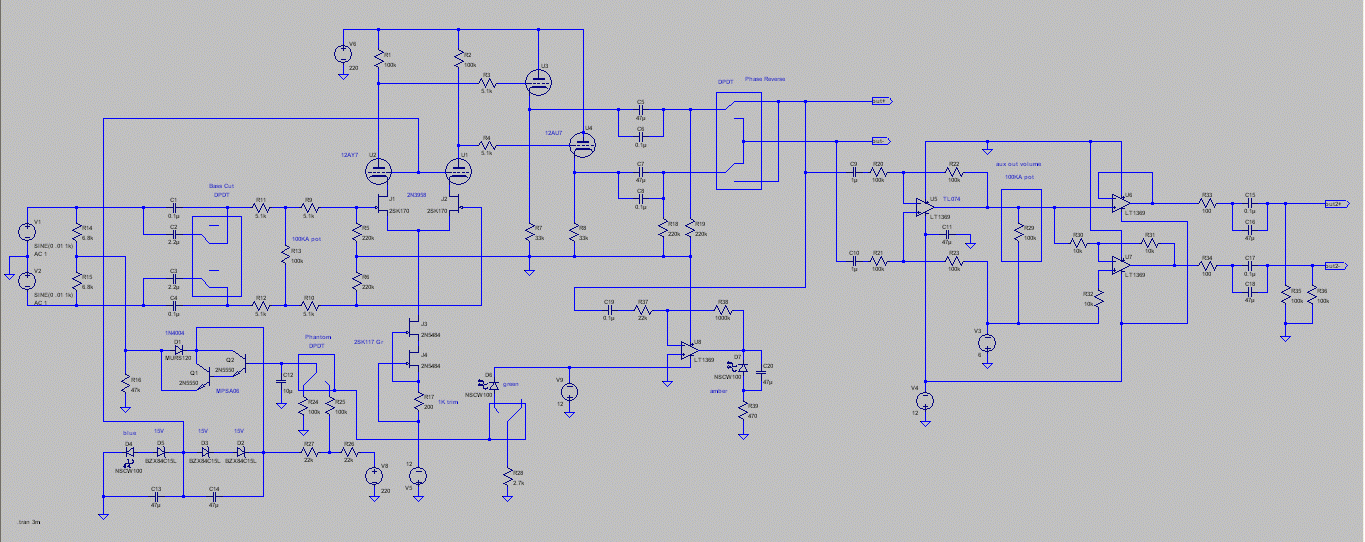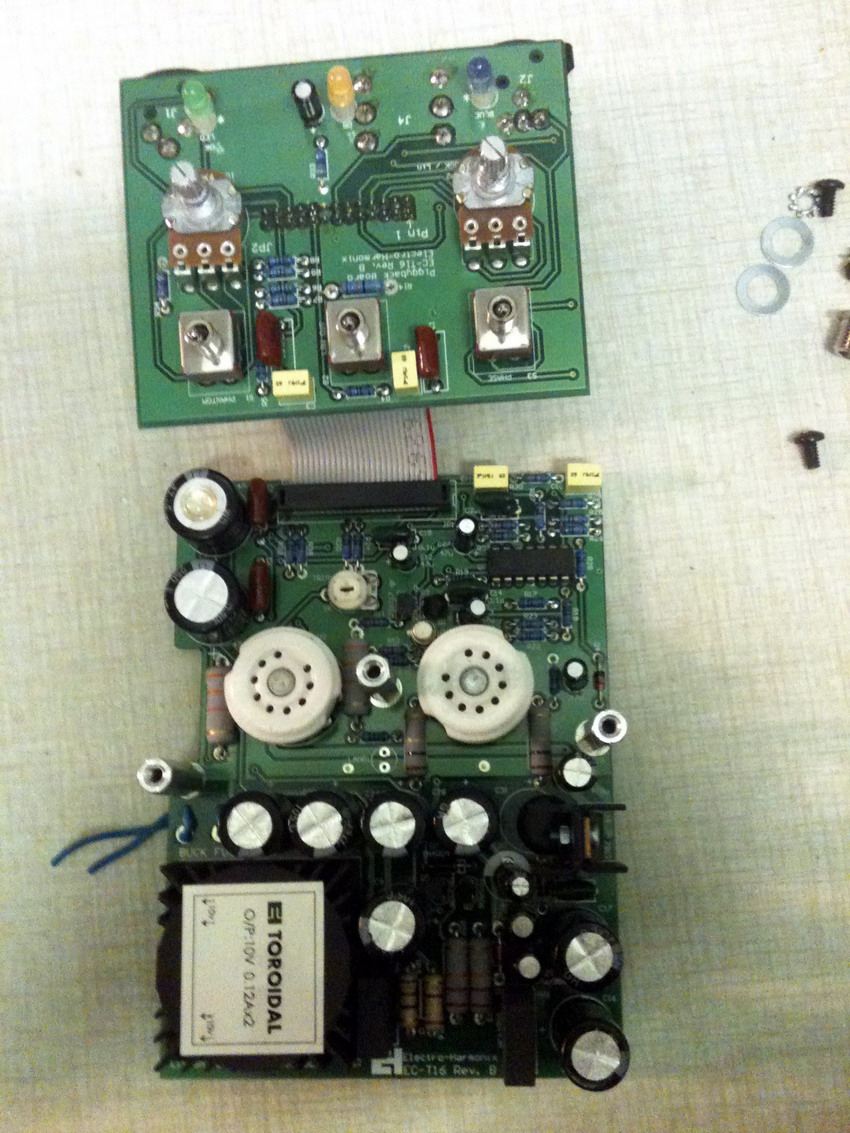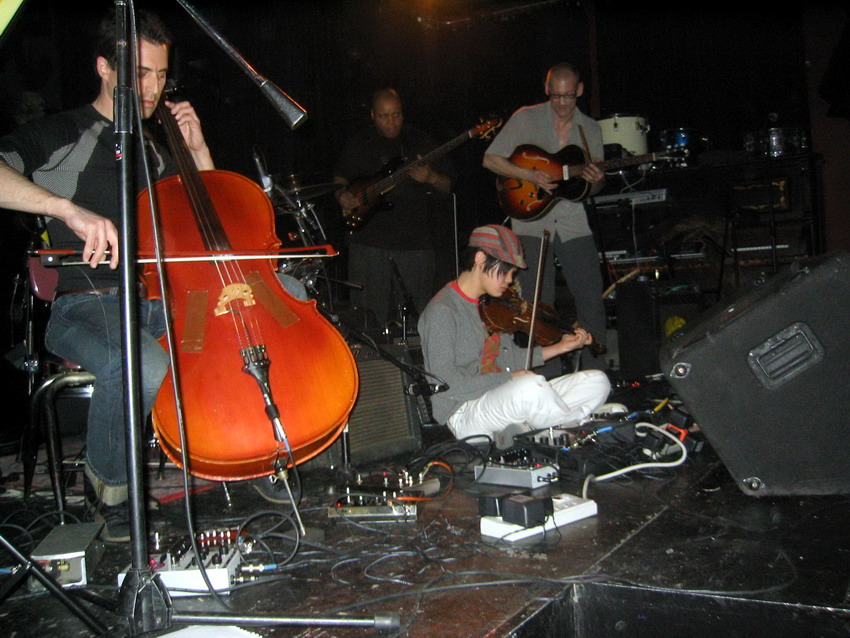as an introduction to what goes into a mic pre, i thought i would start with something very accessible. no vintage collectibles. later on, i will go into some fancy stuff.
some years back, i designed a mic pre for electro harmonix. mike matthews wanted it to be based around one of the “other” reissue 12A_7 type tubes that were new production from reflektor (the tube factory he mostly owns in saratov). partly as a way to sell more other types of tubes. the 12AY7 was a natural choice. i love 12AY7s. the specifications for this pre, and this is where the rubber meets the road, were that it had to fit in a standard EH tube pedal box, it had to use a CE approved wall wart, and the total cost of the bill of materials precluded the possibility of signal transformers. i was sure we could do it and not use an opamp anywhere in the audio path. the retail price mike was shooting for just under 200$. i wanted it to be all tube, and use a high voltage supply. it wasn’t going to be easy.
now there are a lot of cheap ass “tube” mic pres in the “prosumer” market. for example, art© makes a really cheap one that has a tube in it. the tube does nothing good, but you can get some interesting grungy sounds out of the thing… for vocals, with a shure dynamic, it’s actually ok for punk, black metal and even hiphop. and it is really cheap. did i remember to mention that it doesn’t cost very much? don’t waste too much time trying to record something subtle with it though. it has no decent clean sound and is a fair bit on the nasty side. it’s an opamp based mic pre with a 12AX7 with the same 9 volt supply on the plate and on the heater (heater is normally 12 volts…) too. there’s no point expecting a lot.
the tube is arranged as sort of a signal conditioning gadget that adds distortion and EQ. that is what the industry thinks tubes do. this sort of approach is used by korg, and others, as a way to get a tube “inside”, without a high voltage supply or spending a lot of money. the tube markets the product well beyond what it actually is worth. we are talking about the low end, mainly, but you’d be surprised how many of these sorts of products do well? well, maybe not.
as configured, the 12AX7 has a gain of 0.3 – 0.7 (no, it is not a cathode follower), and not all 12AX7s work in the circuit because the operating point is on the edge of conductance. it’s like a diode voltage divider. rolls off the top and adds some child’s law flavored 2nd harmonic distortion. they sell a lot of them. in any case, that was the “competition” we were looking at. mike will probably never sell as many mic pres as most of the makers that focus on that, but they will never sell any fuzz boxes either. he will sell some mic pres. the total cost of the art© thing, before marketing and labor is probably 12 dollars or so… maybe 15$? it was machine assembled in china, and there isn’t much labor in it, but a great deal of marketing. at the time, i’m guessing the 12AX7 cost maybe 6$ wholesale in large quantities (no, you couldn’t buy them for that unless you ordered 10,000 + pieces). it was a tough act to follow. the chassis, pc board and parts consume whatever is left of the budget after they bought the tube. the tube was a third or fourth of the production cost. i hope you keep this all in mind as i continue?
okay. mic pres need certain things just to qualify as such. of course the basic house cleaning was figured out, as well as facilitating the use of different kinds of mics: the feature set took shape. the cost of the unit still stood as a sheer cliff between me and what i wanted to do. but, that is what it is to design consumer electronics generally. i prototyped a few different front ends and a big problem immediately raised it’s head. balance. this is a transformerless design and balanced inputs and outputs are part of what is required to interface with gear upstream and down. without a transformer to isolate the audio from the hostile electronic environment outside, a straight up simple tube diff front end, could NOT produce the common mode rejection necessary. even with a fet current source, the best i could do without adjustments was about 40- 50dB, depending on the tube. i do not design ANYTHING that requires a particular tube. matched tube. special tube… etc. it’s against my religion. it has to work with any tube. the other cheap pre’s on the market are not either very impressive in this regard, but i wanted to do it better. this was the first mic pre EH would put out. cheap or not, i wanted to make an impression. adding a balance pot added 20dB more rejection, for a while anyway. but wasn’t an acceptable solution. no user adjustments, that’s also in the rules of engagement (a prescription for misery if there ever was one).
i had an auto balancing circuit i had designed using tubes in another project long ago, and i thought i could translate it to solid state for this… but the added complexity ate up board space i needed for conveniences, and budget. i had to do something simple. i cheated. the 2N3958 is a dual matched Jfet with a guaranteed CMRR of 100 dB. i made a hybrid cascode diff with fets on bottom, the 12AY7 on top. the jfets weren’t cheap, but i found a source in japan and it was cheaper than the balancing servo. a LOT cheaper than a transformer. it’s a tiny part too, which saved space. and i didn’t have to use an opamp, which would not have had any better CMRR in the price range we were dealing with, and would not have sounded the way i wanted. mike matthews and his people are really good at finding parts for less. that is key for success. i am sure, by now, they have a better source.
the next problem was the power supply. in order to sell things internationally, there is a heap of regulatory hurdles to jump through that is both mind numbing and nasty. nearly all of them are set to hinder or bleed manufacturers from outside a given trade zone. the usa does it too. in europe, the CE is mainly aimed at limiting the onslaught from china and india, and protecting local builders. but it affects US products as well. it has very stringent standards when it comes to radiated and generated emf at the wall. the simplest and most economical way to get around it is to use a CE certified wall wart. then, your gadget only has to comply with the rules set for input/output emf and ground safety. you also have to sacrifice one of every product you make to the testing procedure and cannot group them. this makes the sacrifice cheaper, if you use a common power supply for all of them. getting analog gadgets passed is rarely difficult, especially if you remove the power transformer (the whole purpose of the wall wart). you may hate wall warts but the industry loves them. the other standard that has to be dealt with now, is ROHS. which means it is heavy metal free. lead free solder, no cadmium or mercury anywhere. i am one of those that hates it and keeps a supply of 63/37 eutectic for my own personal use. but to do business, you have to use tin/antimony. it sucks.
mic pres do not make much radiated noise… the linear supplies don’t either. however, the design needed 220VDC at 12mA (B+), 48VDC at 8mA (phantom), 12VDC at 350mA (heaters), 12VDC at 50mA, 6VDC at 20mA and 18VDC (bias). right there you see why art’s little pre just used 9V for everything, even the tube. there is no wall wart that can do all that. so, right away a decision was made to use a 12VAC 1A wall wart. the 12VAC could be directly rectified to make the various little voltages… but could also drive a 12V:220V transformer turned “backwards” to make B+. the 48V phantom supply was the last remaining problem. clearly it had to come from the B+. but here a little transistor regulator could be configured as a “pop free” supply: that ramps up or down from ground to 48V over a short period of time. none of the cheap pres out there had that. it is really annoying to switch it over and forget to mute things first. BANG! one additional issue is that electro harmonix uses many different types of DC wall warts. from 9V to 40V. most of them use the standard barrel connector boss© and others also use for pedals. the possibility of mixing the AC wall wart up with a DC one and blow up something was obvious. we (me and john pisani) also then made a decision to use a different connector: 2 pin european DIN. a most hated connector if there ever was one… but cheap! no one would be able to dumbly plug 12VAC at one amp into their fancy harmonizer or digital delay and cook it.
a word about the output stage. it is 12AU7 cathode followers off the cascode plates… and this is cap coupled using bypassed electrolytic caps! 47uF allows for “driving” 600 ohms. no, it does not have really enough cajones to do that with aplomb. but it sounds good. a bit dirty and old fashioned. i see this as a feature. if you intentionally load the output with 600 ohms, you lose gain and add distortion. really useful R&B sound. yes. heresy for the hifi world. totally ordinary for the pro audio one. these caps are low esr types made for switching supplies. a good tip for you hackers. these 2 caps were near the top in terms of costliness in the BOM. i think the pair of them were almost the same price as the toroidal trans. the bypasses are mylar 0.1uF.
here you see what i did:
a few comments are in order.
mic pres minimally need, in order to be useful, the following features: bass cut (6dB per oct. from between 50 and 80Hz, for vocals mainly); phase reverse switch; phantom supply (+48VDC for condenser mics); some kind of clipping indication; and a pad. there also needs to be some kind of adjustable sensitivity built in for the wildly varying signal level typical of switching from different types of mics and also from close placement. i chose to use an “H” pad with a pot in front of the gain. this pre is open loop. you can’t actively reduce the gain, so the pad is very important. after some development, it became obvious that an aux out would give flexibility for monitoring. we added this with an opamp using the signal at the output of the tube pre.
here are pix of the board…
for the top view, you can see there are 2 boards: a main board and a piggy back board. there is a ribbon connector that joins them. you can see the cut blue wires, which is where the 12VAC goes in. you can see the 10V:220V toroidal transformer used to step up the wall wart current to B+ level. the power supply components are gathered near the bottom of this view. there is a 12V regulator for the heaters and opamp supply. the audio is in the middle and the control stuff on the breakaway board. the quad opamp uses 2 sections for the aux out buffer, one for gain (X1.4), and the last as a clipping indicator driver. you can see the 3 DPDT switches for the phantom, bass cut and phase reverse switches… as well as the green LED to indicate the phantom is on, the amber LED clipping indicater, and the blue “power” LED. the pots are the input “H” pad and the aux volume level.
on the underside you can see that this is a 2 sided board with ground planes on both. you can also see the neutrik PC mount connectors which we did spring for, and we still came in at cost!
there has been some good discussion of this pre over the years since it appeared. the tape op crew got ahold of it and many liked it… some did not. the ratio is pretty good, for to against. i think it still sells well. some problems have surfaced too, but all of them honestly related to the low cost. there are no low cost preamps that do it all. it could use a little more gain just for ribbon mics. one unforeseen issue: there are a number of popular low priced computer interfaces for recording (notably the delta 1010, for example), that do not have truly balanced inputs on particular settings. this means that hum can be coupled from input to output of the pre, in certain situations. it can be fixed using a transformer coupled direct box… but i had hoped to avoid this. i am really satisfied with the end result. i don’t think you can buy a better pre for the same money or even close to double.
ok, so why have i gone through all this? partly to demonstrate the thinking behind its design and just how much cost is a part of the calculation. but also, because it doesn’t take much work to modify this into a very much better mic pre… something that would hold it’s own in any studio. the most important components and features are all here on the board. you would be hard pressed to find all of this for less than the cost of a new one in the box. 2 of these modded, some i/o transformers, and some dedicated power supply upgrades will make for a really high performance stereo mic pre for much less than is possible in the music stores. that’s for the next installment.
and finally, i often left little secret messages on the PC boards. political ones mainly, as Bush was president. matthews is a rabid republican. on this one, there’s a little plug for the band i had at the time… elvisbeatlesgod. most people will never see those little details…
here’s a a few pix of us at SINE. that’s me and gary poulson in the background. gary was actually the drummer! which is nuts because he’s an amazing guitarist. way beyond me. yes, there’s a fair amount of electro harmonix on that stage, as well as a bunch of home made things too! most of it over on my side! but masako kawaii, our singer, used the prototype 12AY7 mic pre at nearly all our gigs. together with a 16 sec digital delay. both maiko endo and jim mckay, the strings, used EH stuff. maiko has a POG, a memory man and a white finger. jim uses a bass micro synth, a TUB EQ (as a wahwah) and a memory man.




